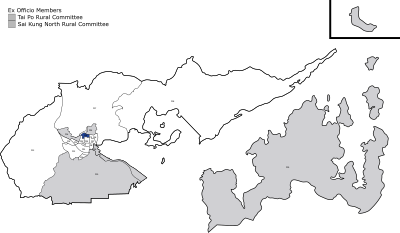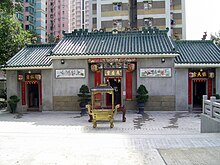Tai Po Market
The first Tai Po Hui (Chinese: 大埔墟; Jyutping: daai6 bou3 heoi1; Cantonese Yale: daaih bou hēui; lit.
In Kangxi Year edition of Xin'an Xianzhi (Gazetteer of the Xin'an County (or San-On County in the Cantonese language)), the market town was also known as Tai Po Tau Hui (大步頭墟; daai6 bou6 tau4 heoi1; daaih bouh tàuh hēui; 'Tai Po Tau Market').
[2] The market town was located in the northern shore of the Lam Tsuen river mouth.
[3] It was said Tai Po Hui was one of the three major market towns of Hong Kong [sic][nb 1] in the early Qing dynasty.
The District Office of the colonial Hong Kong government, also within the proximity of both new and old Tai Po Hui.
The street currently consisted of post-Qing dynasty buildings, except a well and a Man Mo Temple.
[7] The temple, at the heart of the Fu Shin Street, is a declared monument of Hong Kong.
As the main circular road was intended to facilitate the movement of troops, it avoided the centres of population.


